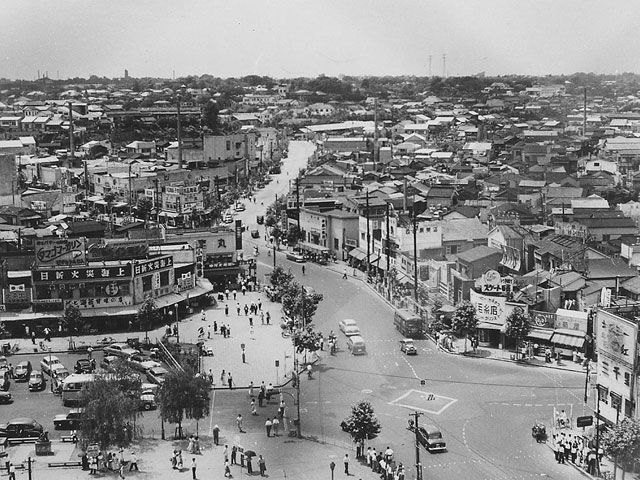Serving over 2 million passengers a day, Shibuya Station is one of the busiest rail and subway hubs in Japan. Like its larger sister station Shinjuku to the north, its history reflects the sweeping change that has transformed Japan since the country’s first railway opened in 1872.

Shibuya Station opened in 1885 as a stop on Nippon Railway’s Akabane-Shinagawa Line, the predecessor of the Yamanote Line circling central Tokyo. A sleepy residential backwater at the time, Shibuya quickly grew into a lively commercial and entertainment district, incorporating into a village in 1889 and a town 20 years later.
In 1907, the Tamagawa Electric Railway began a tram service from Shibuya to Futakotamagawa on the Tama River, which separates Tokyo from Kawasaki to the southwest. Around that time, Shibuya Station was a small brick building with a tower, not unlike the present Harajuku Station on the JR Yamanote Line, and many of its passengers would arrive and depart by rickshaw.

Shibuya Station in the early 20th century
In 1927, Tokyu Corporation began service along a railway that would eventually link to Yokohama, setting Shibuya on a path toward becoming one of Tokyo’s major rail hubs along with Shinjuku, Ikebukuro, Ueno, Tokyo and Shinagawa. Headed by the prominent industrialist Keita Goto (1882-1959), Tokyu grew into a transport and retail empire and took over the Tamagawa tramway, eventually burying most of it. Renamed the Den-en Toshi Line, it’s now a major commuter railway of 31 km serving western Tokyo and Kanagawa Prefecture, where its terminus is Chuo-Rinkan.
Aside from Tokyu and JR East, which inherited the Yamanote Line and other railways from its predecessor Japanese National Railways, Shibuya Station is also served by Keio Corporation’s Inokashira Line, which opened in 1933 with service extending to Kichijoji the following year.

Shibuya Crossing in the 1950s
The other important growth factor for Shibuya Station has been subway service. Shibuya is one terminus of the famous Ginza Line, a portion of which opened in 1927 as the first subway in East Asia; it was extended to Shibuya in 1939. Now operated by Tokyo Metro, its yellow-striped cars travel 14 km through central Tokyo, including the posh Ginza shopping district, ending at Asakusa, site of the historic Senso-ji Buddhist temple.

Shibuya Station’s east side around 1960
Shibuya didn’t get another subway line until 1978, when a section of the present Hanzomon Line, also run by Tokyo Metro, opened to Aoyama-itchome. Extensions were made over the past few decades, notably avoiding tunneling under the Imperial Palace (home of Japan’s emperor) at the heart of Tokyo; the line is named after the palace’s Hanzomon Gate. The Hanzomon Line currently reaches Oshiage, site of the recently built Tokyo Sky Tree, and has through-service connections with Tobu Railway lines at Oshiage as well as the Tokyu Den-en Toshi Line at Shibuya.

Another view of the station in 1960
To help ease congestion on the JR Yamanote Line, Tokyo Metro completed the capital’s newest (and deepest) subway, the Fukutoshin Line, in 2008. Extending 20 km to Wakoshi in Saitama Prefecture north of Tokyo, the Fukutoshin Line has through services to Yokohama on the Tokyu Toyoko Line as well as Hanno and Kawagoeshi on the Seibu Ikebukuro Line and the Tobu Tojo Line, respectively.
Shibuya Station and the surrounding area are now undergoing a massive multiyear redevelopment under the auspices of JR East and the Tokyu conglomerate, which centers its rail and retail operations here. In 2012, Tokyu opened Shibuya Hikarie, a skyscraper with offices, shops and Broadway musical venue Tokyu Theatre Orb, on the east side of the station. The following year, Tokyu buried the station for the Toyoko Line, clearing the way for new structures. Three buildings soaring 46, 10 and 13 stories will crown the redesigned station on the east side, in the middle and on the west side, respectively; JR lines will be moved to improve access. Skyscrapers for offices, startups, shops and residences will also be erected to the south and southwest of the station will gradually transform the area through 2027, when all projects are slated to be complete.
Article by Tim Hornyak. All rights reserved.
